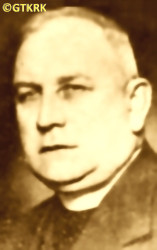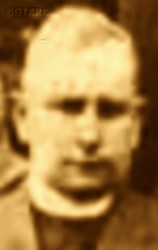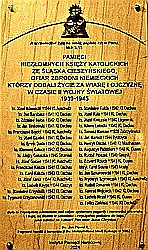Roman Catholic
St Sigismund parish
05-507 Słomczyn
85 Wiślana Str.
Konstancin deanery
Warsaw archdiocese, Poland
full list:
displayClick to display full list

searchClick to search full list by categories
wyświetlKliknij by wyświetlić pełną listę po polsku

szukajKliknij by przeszukać listę wg kategorii po polsku

Martyrology of the clergy — Poland
XX century (1914 – 1989)
personal data
surname
PŁOSZEK
forename(s)
Rudolph (pl. Rudolf)
function
diocesan priest
creed
Latin (Roman Catholic) Church RCmore on
en.wikipedia.org
[access: 2014.09.21]
diocese / province
Katowice diocesemore on
en.wikipedia.org
[access: 2013.05.19]
Wrocław archdiocesemore on
en.wikipedia.org
[access: 2013.05.19]
Wrocław diocesemore on
en.wikipedia.org
[access: 2013.05.19]
date and place
of death
05.10.1940

HnojníkTrans‐Olza
today: Frýdek‐Místek dist., Moravian‐Silesian reg., Czechia
more on
en.wikipedia.org
[access: 2022.01.28]
details of death
During I World from from 1914 chaplain of Austro–Hungarian army.
Taken POW by the Russians.
Released in on 01.07.1918.
After German ian invasion of Poland on 01.09.1939 (Russians invaded Poland 17 days later) and start of the World War II arrested on 08.09.1939 by the Germans.
Interned in Cieszyn military barracks and next in Cieszyn prison.
Maltreated and beaten up.
Released at the beginning of 10.1939 (or on 26.09.1939) with swollen legs and face.
Held in house arrest without the right to say Holy Mass in his church and conduct normal priestly duties.
Did not recover and died.
cause of death
exhaustion and disease
perpetrators
Germans
sites and events
CieszynClick to display the description, Regierungsbezirk KattowitzClick to display the description, «Intelligenzaktion Schlesien»Click to display the description, «Intelligenzaktion»Click to display the description, Ribbentrop‐MolotovClick to display the description, Pius XI's encyclicalsClick to display the description
date and place
of birth
17.04.1880

TřinecTrans‐Olza
today: Frýdek‐Místek dist., Moravian‐Silesian reg., Czechia
more on
en.wikipedia.org
[access: 2022.02.15]
presbyter (holy orders)
ordination
23.07.1907

positions held
1918 – 1940
parish priest — HnojníkTrans‐Olza
today: Frýdek‐Místek dist., Moravian‐Silesian reg., Czechia
more on
en.wikipedia.org
[access: 2022.01.28] ⋄ Assumption of the Blessed Virgin Mary RC parish ⋄ FrýdekTrans‐Olza
today: part of Frýdek‐Místek, Frýdek‐Místek dist., Moravian‐Silesian reg., Czechia
more on
en.wikipedia.org
[access: 2022.02.15] RC deanery
secretary — (Czechoslovakia territory)today: Czekia and Slovakia
more on
en.wikipedia.org
[access: 2023.11.24] ⋄ Union of Silesian Catholics
membership — Polish People's Society
activist — Polish School Society PMS
membership — „Silesian Beskids”
founder — magazine, „Our country”
1913 – 1914
administrator — HnojníkTrans‐Olza
today: Frýdek‐Místek dist., Moravian‐Silesian reg., Czechia
more on
en.wikipedia.org
[access: 2022.01.28] ⋄ Assumption of the Blessed Virgin Mary RC parish ⋄ FrýdekTrans‐Olza
today: part of Frýdek‐Místek, Frýdek‐Místek dist., Moravian‐Silesian reg., Czechia
more on
en.wikipedia.org
[access: 2022.02.15] RC deanery
vicar — TřinecTrans‐Olza
today: Frýdek‐Místek dist., Moravian‐Silesian reg., Czechia
more on
en.wikipedia.org
[access: 2022.02.15] ⋄ St Albert of Jerusalem and Our Lady of Sorrows RC parish ⋄ JablunkovTrans‐Olza
today: Frýdek‐Místek dist., Moravian‐Silesian reg., Czechia
more on
en.wikipedia.org
[access: 2022.01.28] RC deanery
1912 – 1913
administrator — Zarzeczetoday: Chybie gm., Cieszyn pov., Silesia voiv., Poland
more on
en.wikipedia.org
[access: 2022.02.15] ⋄ Our Lady of the Snow RC parish ⋄ Strumieńtoday: Strumień gm., Cieszyn pov., Silesia voiv., Poland
more on
en.wikipedia.org
[access: 2021.12.18] RC deanery
1911 – 1912
vicar — Zarzeczetoday: Chybie gm., Cieszyn pov., Silesia voiv., Poland
more on
en.wikipedia.org
[access: 2022.02.15] ⋄ Our Lady of the Snow RC parish ⋄ Strumieńtoday: Strumień gm., Cieszyn pov., Silesia voiv., Poland
more on
en.wikipedia.org
[access: 2021.12.18] RC deanery
1910 – 1911
vicar — Ustrońtoday: Ustroń urban gm., Cieszyn pov., Silesia voiv., Poland
more on
en.wikipedia.org
[access: 2021.12.18] ⋄ St Clement, the Pope and Martyr RC parish ⋄ Cieszyntoday: Cieszyn gm., Cieszyn pov., Silesia voiv., Poland
more on
en.wikipedia.org
[access: 2021.12.18] RC deanery
1909 – 1910
vicar — Mikulovicetoday: Jeseník dist., Olomouc reg., Czechia
more on
en.wikipedia.org
[access: 2022.02.15] ⋄ RC parish ⋄ Frývaldovtoday: Jeseník, Jeseník dist., Olomouc reg., Czechia
more on
en.wikipedia.org
[access: 2022.02.15] RC deanery
1908 – 1909
vicar — Bernarticetoday: Jeseník dist., Olomouc reg., Czechia
more on
en.wikipedia.org
[access: 2022.02.15] ⋄ RC parish ⋄ Janowa Góratoday: Stronie Śląskie gm., Kłodzko pov., Lower Silesia voiv., Poland
more on
en.wikipedia.org
[access: 2022.02.15] RC deanery
1907 – 1908
vicar — Vlčicetoday: Jeseník dist., Olomouc reg., Czechia
more on
en.wikipedia.org
[access: 2022.02.15] ⋄ RC parish ⋄ Janowa Góratoday: Stronie Śląskie gm., Kłodzko pov., Lower Silesia voiv., Poland
more on
en.wikipedia.org
[access: 2022.02.15] RC deanery
vicar — (Trans‐Olza, Cieszyn Silesia region)today: Moravian‐Silesian reg., Czechia
more on
en.wikipedia.org
[access: 2023.11.24] — in German parishes
till 1907
student — Vidnavatoday: Jeseník dist., Olomouc reg., Czechia
more on
en.wikipedia.org
[access: 2021.12.18] ⋄ philosophy and theology, Theological Seminary
others related
in death
ADAMECKIClick to display biography Joseph, BARABASZClick to display biography John Nepomucene, GALOCZClick to display biography Clement, KAŁUŻAClick to display biography Francis Matthew, KAŁUŻAClick to display biography Charles, KUKLAClick to display biography Stanislav, KULAClick to display biography Joseph, OLSZAKClick to display biography Henry, PAŹDZIORAClick to display biography Augustine, SZYMECZEKClick to display biography Frederick, TOMANEKClick to display biography Rudolph Ignatius, WRZOŁClick to display biography Louis Michael, KNYPSClick to display biography Louis, MAROSZClick to display biography John, SOSNAClick to display biography Charles
sites and events
descriptions
Cieszyn: Remand jail run by German political police Gestapo — in the southern part (today: Czech) of town — and investigative prison — in northern (Polish) side, on the other bank of Olza river — run by Germans. In 1940 the prisoners were initially held in Cieszyn jail but next, due to an overcrowding, taken to former Josef and Jacob Kohn furniture manufacturing plant, by Frydecka Str. and Jabłonkowa Str. junction on the southern bank of Olza, where a transit camp was set up. The prisoners — more than 1,000 Poles went through the camp — were interrogated and whipped with horsewhips, prior to being sent to German concentration camps. (more on: www.sw.gov.plClick to attempt to display webpage
[access: 2013.08.10])
Regierungsbezirk Kattowitz: After the Polish defeat in the 09.1939 campaign, which was the result of the Ribbentrop‐Molotov Pact and constituted the first stage of World War II, and the beginning of German occupation in part of Poland (in the other, eastern part of Poland, the Russian occupation began), the Germans divided the occupied Polish territory into five main regions (and a few smaller). The largest one was transformed into Germ. Generalgouvernement (Eng. General Governorate), intended exclusively for Poles and Jews and constituting part of the so‐called Germ. Großdeutschland (Eng. Greater Germany). From two separate new provinces were created. The two remaining were incorporated into existing German provinces. One of those was Polish Upper Silesia, which on 08.09.1939, by decree of the German leader Adolf Hitler (formally came into force on 26.10.1939), was incorporated into Germany as the Germ. Regierungsbezirk Kattowitz (Eng. Katowice Regency) and became part of the Germ. Provinz Schlesien (Eng. Province of Silesia) based in Wrocław. On 01.04.1940, the Germ. Regierungsbezirk Kattowitz was enlarged by several pre‐war German counties, and on 18.01.1941, a new German province was created, the Germ. Provinz Oberschlesien (Eng. Province of Upper Silesia), which, apart from the Germ. Regierungsbezirk Kattowitz, also included the Opole region. From 26.10.1939, when the regency was established, the law of the German state was in force there, the same as in Berlin. The main axis of the policy of the new regency, the territory of which the Germans recognized as the Germ. „Ursprünglich Deutsche” (Eng. „natively German”), despite the fact only 6% of its pre–war Polish part were Germans, was Germ. „Entpolonisierung” (Eng. „Depolonisation”), i.e. forced Germanization. The main mechanism was the introduction of the Germ. Deutsche Volksliste DVL, a German nationality list that was supposed to specify the national affiliation of the inhabitants of the region. The largest group marked in the compulsory registrations was Group 3, people who identified themselves as „Silesians” (in 1943 about 41%), and people remaining outside the DVL (about 36%). The latter group was intended to be deported to the Germ. Generalgouvernement (which did not happen en masse because German industry needed slave labor). Group 3, considered by the Germans as capable of Germanization, was subject to certain legal restrictions, and was subject to, among others, to conscription into the German Wehrmacht army. Children could only learn in German. A policy of terror was pursued against the Polish population. There was a special police court, controlled by the Germ. Geheime Staatspolizei (Eng. Secret State Police), i.e. the Gestapo, before which c. 4,000‐5,000 people were detained. For the years 1942‐1945 over 2,000 of them were verified, of which 1,890 were sentenced to death, including 286 in public executions. Thousands of people were murdered during the so‐called «Intelligenzaktion Schlesien», including 300‐650 Polish teachers and c. 61 Polish Catholic priests. The regency hosted a German concentration and extermination camp KL Auschwitz, where the Germans imprisoned c. 1,100,000 Jews (murdering c.1,000,000, i.e. c. 90% of them) and c. 140,000 Poles (murdering c. 70,000, i.e. c. 50% of them). After the end of hostilities of World War II, the overseer of this province, the Germ. Reichsstatthalter (Eng. Reich Governor) and the Germ. Gauleiter (Eng. district head) of the German National Socialist Party, Fritz Brecht, committed suicide. (more on: en.wikipedia.orgClick to attempt to display webpage
[access: 2024.06.24])
«Intelligenzaktion Schlesien»: A planned action of arrests and extermination of Polish Upper Silesia intellectual elite in general recorded in of the so‐called Germ. Sonderfahndungsliste (Eng. Special Wanted List), i.e. a proscription list of names of „enemies of the Reich” — participants of Upper Silesia uprisings, former Polish plebiscite activists, journalists, politicians, intellectuals, civil servants, priests — organised by Germans mainly in 04‐05.1940, aiming at total Germanisation of the region. The relevant decree, no IV‐D2‐480/40, was issued by the RSHA, i.e. Germ. Reichssicherheitshauptamt (Eng. Reich Security Office), and signed by Heinrich Himmler or Reinhard Heydrich. Some of those arrested were murdered in mass executions, some were deported to the German‐run Germ. Generalgouvernement (Eng. General Governorate), and some were sent to concentration camps. The personal details of 3,047 people deported within two months of 1940 were established. Among the victims were 33 Catholic priests, 22 of whom perished in concentration camps (the clergy were sent — in 5 transports — first to KL Dachau, and then to KL Gusen, where they slaved in quarries). Altogether, the Germans murdered c. 2,000 members of the Polish Upper Silesia intellectual elite. (more on: pl.wikipedia.orgClick to attempt to display webpage
[access: 2016.05.30])
«Intelligenzaktion»: German: «Intelligenzaktion» (English: „Intelligence Action”) — a German program of extermination of the Polish elite, mainly the intelligentsia and leadership layers, carried out from the beginning of the occupation in w 09.1939 to 04.1940, mainly in territories directly annexed to Germany, but also in the so‐called Germ. Generalgouvernement (Eng. General Governorate), where it was called «AB‐aktion». In the first phase, immediately after the beginning of the German occupation, during military operations carried out by the Germ. Wehrmacht (Eng. Armed Forces) and the genocidal units of the Germ. Einsatzgruppen (Eng. Operational Groups) of the Germ. Sicherheitspolizei (Eng. Security Police), i.e. SiPo, and Germ. Sicherheitsdienst des Reichsführers SS (Eng. Security Service of the Reichsführer SS), i.e. SD, organized by the Germ. Reichssicherheitshauptamt (Eng. Reich Main Security Office), i.e. RSHA, which followed the troops, carried out under the Germ. Unternehmen „Tannenberg” (Eng. Operation „Tannenberg”) — based on the so‐called Germ. Sonderfahndungsliste (Eng. Special Wanted Lists), i.e. proscription lists of Poles considered particularly dangerous to the Third Reich, prepared by the Zentralstelle II/P (Polen) unit of the German RSHA. Later, implemented by the German civilian occupation authorities and the genocidal unit of the Germ. Volksdeutscher Selbstschutz (Eng. Ethnic Germans Self‐Defense), whose members were Germ. Volksdeutsche (Eng. Ethnic Germans), i.e. representatives of the German minority in Poland. According to various sources, these lists, at the beginning of 09.1939, could have contained the details of 61,000—88,000 „dangerous” Poles — although these figures cannot be confirmed. In total, during this genocide, c. 50,000 teachers, Catholic priests, representatives of the landed gentry, freelancers, social and political activists, and retired military personnel were systematically and methodically murdered. Another 50,000 were sent to concentration camps, where only a negligible percentage survived. (more on: en.wikipedia.orgClick to attempt to display webpage
[access: 2014.10.04])
Ribbentrop‐Molotov: Genocidal Russian‐German alliance pact between Russian leader Joseph Stalin and German leader Adolf Hitler signed on 23.08.1939 in Moscow by respective foreign ministers, Mr. Vyacheslav Molotov for Russia and Joachim von Ribbentrop for Germany. The pact sanctioned and was the direct cause of joint Russian and German invasion of Poland and the outbreak of the World War II in 09.1939. In a political sense, the pact was an attempt to restore the status quo ante before 1914, with one exception, namely the „commercial” exchange of the so‐called „Kingdom of Poland”, which in 1914 was part of the Russian Empire, fore Eastern Galicia (today's western Ukraine), in 1914 belonging to the Austro‐Hungarian Empire. Galicia, including Lviv, was to be taken over by the Russians, the „Kingdom of Poland” — under the name of the General Governorate — Germany. The resultant „war was one of the greatest calamities and dramas of humanity in history, for two atheistic and anti‐Christian ideologies — national and international socialism — rejected God and His fifth Decalogue commandment: Thou shall not kill!” (Abp Stanislav Gądecki, 01.09.2019). The decisions taken — backed up by the betrayal of the formal allies of Poland, France and Germany, which on 12.09.1939, at a joint conference in Abbeville, decided not to provide aid to attacked Poland and not to take military action against Germany (a clear breach of treaty obligations with Poland) — were on 28.09.1939 slightly altered and made more precise when a treaty on „German‐Russian boundaries and friendship” was agreed by the same murderous signatories. One of its findings was establishment of spheres of influence in Central and Eastern Europe and in consequence IV partition of Poland. In one of its secret annexes agreed, that: „the Signatories will not tolerate on its respective territories any Polish propaganda that affects the territory of the other Side. On their respective territories they will suppress all such propaganda and inform each other of the measures taken to accomplish it”. The agreements resulted in a series of meeting between two genocidal organization representing both sides — German Gestapo and Russian NKVD when coordination of efforts to exterminate Polish intelligentsia and Polish leading classes (in Germany called «Intelligenzaktion», in Russia took the form of Katyń massacres) where discussed. Resulted in deaths of hundreds of thousands of Polish intelligentsia, including thousands of priests presented here, and tens of millions of ordinary people,. The results of this Russian‐German pact lasted till 1989 and are still in evidence even today. (more on: en.wikipedia.orgClick to attempt to display webpage
[access: 2015.09.30])
Pius XI's encyclicals: Facing the creation of two totalitarian systems in Europe, which seemed to compete with each other, though there were more similarities than contradictions between them, Pope Pius XI issued in 03.1937 (within 5 days) two encyclicals. In the „Mit brennender Sorge” (Eng. „With Burning Concern”) published on 14.03.1938, condemned the national socialism prevailing in Germany. The Pope wrote: „Whoever, following the old Germanic‐pre‐Christian beliefs, puts various impersonal fate in the place of a personal God, denies the wisdom of God and Providence […], whoever exalts earthly values: race or nation, or state, or state system, representatives of state power or other fundamental values of human society, […] and makes them the highest standard of all values, including religious ones, and idolizes them, this one […] is far from true faith in God and from a worldview corresponding to such faith”. On 19.03.1937, published „Divini Redemptoris” (Eng. „Divine Redeemer”), in which criticized Russian communism, dialectical materialism and the class struggle theory. The Pope wrote: „Communism deprives man of freedom, and therefore the spiritual basis of all life norms. It deprives the human person of all his dignity and any moral support with which he could resist the onslaught of blind passions […] This is the new gospel that Bolshevik and godless communism preaches as a message of salvation and redemption of humanity”… Pius XI demanded that the established human law be subjected to the natural law of God , recommended the implementation of the ideal of a Christian state and society, and called on Catholics to resist. Two years later, National Socialist Germany and Communist Russia came together and started World War II. (more on: www.vatican.vaClick to attempt to display webpage
[access: 2023.05.28], www.vatican.vaClick to attempt to display webpage
[access: 2023.05.28])
sources
personal:
www.ceeol.comClick to attempt to display webpage
[access: 2017.11.07], turystyka.jaworze.plClick to attempt to display webpage
[access: 2017.11.07]
original images:
bsip.miastorybnik.plClick to attempt to display webpage
[access: 2020.05.25], turystyka.jaworze.plClick to attempt to display webpage
[access: 2017.11.07], diecezja.bielsko.plClick to attempt to display webpage
[access: 2025.01.29]
LETTER to CUSTODIAN/ADMINISTRATOR
If you have an Email client on your communicator/computer — such as Mozilla Thunderbird, Windows Mail or Microsoft Outlook, described at WikipediaPatrz:
en.wikipedia.org, among others — try the link below, please:
LETTER to CUSTODIAN/ADMINISTRATORClick and try to call your own Email client
If however you do not run such a client or the above link is not active please send an email to the Custodian/Administrator using your account — in your customary email/correspondence engine — at the following address:

giving the following as the subject:
MARTYROLOGY: PŁOSZEK Rudolph
To return to the biography press below:
 Click to return to biography
Click to return to biography










